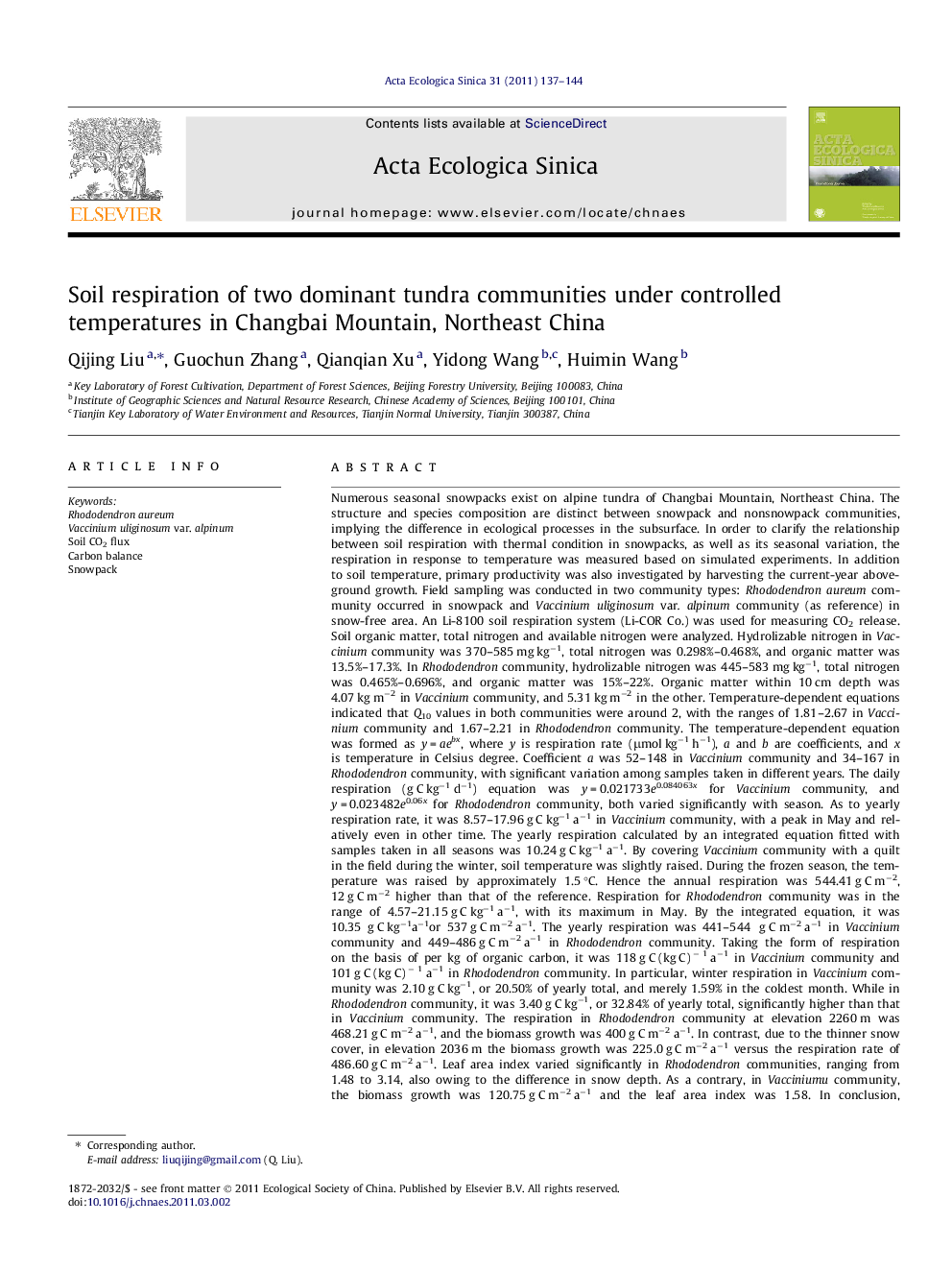| Article ID | Journal | Published Year | Pages | File Type |
|---|---|---|---|---|
| 4380034 | Acta Ecologica Sinica | 2011 | 8 Pages |
Abstract
Numerous seasonal snowpacks exist on alpine tundra of Changbai Mountain, Northeast China. The structure and species composition are distinct between snowpack and nonsnowpack communities, implying the difference in ecological processes in the subsurface. In order to clarify the relationship between soil respiration with thermal condition in snowpacks, as well as its seasonal variation, the respiration in response to temperature was measured based on simulated experiments. In addition to soil temperature, primary productivity was also investigated by harvesting the current-year aboveground growth. Field sampling was conducted in two community types: Rhododendron aureum community occurred in snowpack and Vaccinium uliginosum var. alpinum community (as reference) in snow-free area. An Li-8100 soil respiration system (Li-COR Co.) was used for measuring CO2 release. Soil organic matter, total nitrogen and available nitrogen were analyzed. Hydrolizable nitrogen in Vaccinium community was 370-585 mg kgâ1, total nitrogen was 0.298%-0.468%, and organic matter was 13.5%-17.3%. In Rhododendron community, hydrolizable nitrogen was 445-583 mg kgâ1, total nitrogen was 0.465%-0.696%, and organic matter was 15%-22%. Organic matter within 10 cm depth was 4.07 kg mâ2 in Vaccinium community, and 5.31 kg mâ2 in the other. Temperature-dependent equations indicated that Q10 values in both communities were around 2, with the ranges of 1.81-2.67 in Vaccinium community and 1.67-2.21 in Rhododendron community. The temperature-dependent equation was formed as y = aebx, where y is respiration rate (μmol kgâ1 hâ1), a and b are coefficients, and x is temperature in Celsius degree. Coefficient a was 52-148 in Vaccinium community and 34-167 in Rhododendron community, with significant variation among samples taken in different years. The daily respiration (g C kgâ1 dâ1) equation was y = 0.021733e0.084063x for Vaccinium community, and y = 0.023482e0.06x for Rhododendron community, both varied significantly with season. As to yearly respiration rate, it was 8.57-17.96 g C kgâ1 aâ1 in Vaccinium community, with a peak in May and relatively even in other time. The yearly respiration calculated by an integrated equation fitted with samples taken in all seasons was 10.24 g C kgâ1 aâ1. By covering Vaccinium community with a quilt in the field during the winter, soil temperature was slightly raised. During the frozen season, the temperature was raised by approximately 1.5 °C. Hence the annual respiration was 544.41 g C mâ2, 12 g C mâ2 higher than that of the reference. Respiration for Rhododendron community was in the range of 4.57-21.15 g C kgâ1 aâ1, with its maximum in May. By the integrated equation, it was 10.35 g C kgâ1aâ1or 537 g C mâ2 aâ1. The yearly respiration was 441-544  g C mâ2 aâ1 in Vaccinium community and 449-486 g C mâ2 aâ1 in Rhododendron community. Taking the form of respiration on the basis of per kg of organic carbon, it was 118 g C (kg C) â 1 aâ1 in Vaccinium community and 101 g C (kg C) â 1 aâ1 in Rhododendron community. In particular, winter respiration in Vaccinium community was 2.10 g C kgâ1, or 20.50% of yearly total, and merely 1.59% in the coldest month. While in Rhododendron community, it was 3.40 g C kgâ1, or 32.84% of yearly total, significantly higher than that in Vaccinium community. The respiration in Rhododendron community at elevation 2260 m was 468.21 g C mâ2 aâ1, and the biomass growth was 400 g C mâ2 aâ1. In contrast, due to the thinner snow cover, in elevation 2036 m the biomass growth was 225.0 g C mâ2 aâ1 versus the respiration rate of 486.60 g C mâ2 aâ1. Leaf area index varied significantly in Rhododendron communities, ranging from 1.48 to 3.14, also owing to the difference in snow depth. As a contrary, in Vacciniumu community, the biomass growth was 120.75 g C mâ2 aâ1 and the leaf area index was 1.58. In conclusion, snowpacks provide a suitable condition for microbiomes in the winter, and contribute a large proportion of respiration. This also implies the vigorous activity in nitrogen release during the frozen season, which results in the rapid thriving of plants after snowmelt.
Keywords
Related Topics
Life Sciences
Agricultural and Biological Sciences
Ecology, Evolution, Behavior and Systematics
Authors
Qijing Liu, Guochun Zhang, Qianqian Xu, Yidong Wang, Huimin Wang,
